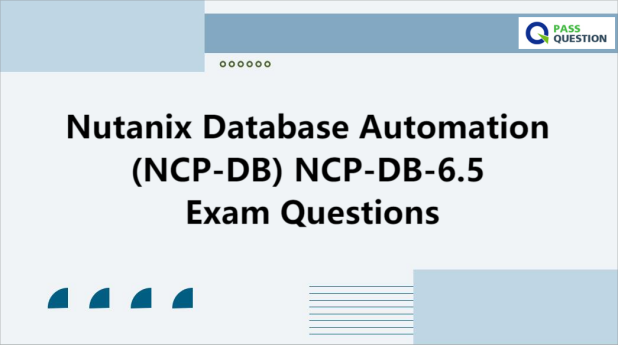Nutanix Database Automation (NCP-DB) NCP-DB-6.5 Exam Questions
Are you getting ready for your NCP-DB-6.5 Nutanix Certified Professional - Database Automation (NCP-DB) v6.5 exam? If so, we have great news for you! PassQuestion offers a wide range of the latest Nutanix Database Automation (NCP-DB) NCP-DB-6.5 Exam Questions that can greatly assist you in preparing for the exam. By using our comprehensive Nutanix Database Automation (NCP-DB) NCP-DB-6.5 Exam Questions, you can boost your confidence and increase your chances of passing the Nutanix NCP-DB-6.5 exam on your very first attempt. Don't miss out on this amazing opportunity to enhance your exam preparation!

Nutanix Certified Professional - Database Automation (NCP-DB)
The Nutanix Certified Professional - Database Automation (NCP-DB) 6.5 certification measures your ability to deploy, administer, optimize, and troubleshoot database workloads using Nutanix Database Service (NDB).
Successful candidates have approximately 1-2 years of database management experience, while having at least 6 months of Nutanix Database Service or Nutanix Era experience. They are typically database administrators, Nutanix technical employees, Nutanix channel partners, Nutanix OEM vendors, and Nutanix customers who are capable of successfully provisioning, patching, protecting, and cloning NDB-managed databases.
Exam Details
Format: 75 multiple choice questions
Time Limit: 120 minutes
Language: English and Japanese
Pricing: $199 USD
Knowledge Objectives
Section 1 – Describe NDB Concepts
- Define database and NDB terminology
- Describe NDB features and benefits
Section 2 – Deploy and Configure an NDB Solution
- Deploy an NDB Instance
- Configure an NDB Instance
- Configure NDB High Availability
Section 3 - Monitor Alerts and Storage Usage Within an NDB Implementation
- Monitor alerts
- Monitor and manage storage usage
Section 4 - Operate and Maintain an NDB Environment
- Apply procedural concepts to register database server VMs and databases
- Apply procedural concepts to provision databases
- Apply procedural concepts to test and publish database patches
- Determine the correct method to apply Linux OS patches
- Upgrade databases
- Given a scenario, troubleshoot NDB operations
Section 5 - Protect NDB-managed Databases Using Time Machine
- Create, delete, and modify SLA retention policies
- Given business requirements, perform a database clone
- Apply procedural concepts to restore source databases
- Refresh clones
- Apply policies to protect databases
- Apply procedural concepts to create Data Access Management (DAM) policies
Section 6 - Administer an NDB Environment
- Manage NDB profiles
- Perform NDB software upgrades
- Apply procedural concepts to add Nutanix clusters to NDB
- Manage networks in NDB
- Manage access controls in NDB
- Identify how to use NDB APIs and CLI
View Online Database Automation (NCP-DB) v6.5 NCP-DB-6.5 Free Questions
1. When trying to restore a database via Time Machine (TM), the option to restore data to a Point in Time is not available.
What should the administrator do to enable Point in Time Recovery?
A.Use an SLA that supports Continuous Log retention.
B.Update the TM schedule to perform DB Log catch up.
C.Take a Manual snapshot and use it for DB recovery.
D.Use Brass SLA & update the Log catch up frequency.
Answer: C
2. An administrator needs to restore a source database from a snapshot. The database shares the source volume with multiple other databases.
How does NDB handle this database restore operation?
A.Copies the specific database files to the source volume
B.Replaces source volume with specific db disks
C.Replaces the source volume with the snapshot volume
D.Copies all database files to the source volume
Answer: A
3. An administrator is tasked with auditing NDB SLAs. What data will the administrator be reviewing?
A.Snapshot schedules
B.Clone Management
C.Data retention policies
D.Recovery Time Objective
Answer: C
4. What is the purpose of Data Access Management policies in NDB Multi-Cluster?
A.To register multiple Nutanix clusters in NDB
B.To perform snapshot operations on a single Nutanix cluster
C.To manage time machine data availability across all registered Nutanix clusters in NDB
D.To remove data accessibility of a time machine across all registered Nutanix clusters in NDB
Answer: C
5. An administrator would like to replicate database snapshots to remote Nutanix clusters.
What should the administrator do to manage Time Machine data availability across all registered
Nutanix clusters in NDB?
A. Add Data Access to each Nutanix cluster and assign a DAM policy.
B. Update the cluster's Data Access & select the remote cluster.
C. Update the SLA on the Time Machine & schedule the remote replication.
D. Select the snapshots & replicate them to each Nutanix cluster.
Answer: A
6. Which statement is true regarding the NDB alert retention feature?
A. NDB supports alert retention globally.
B. NDB supports retention at the individual policy.
C. NDB supports retention at the grouped policy.
D. NDB supports retention at the registered cluster.
Answer: B
7. An administrator needs to patch a PostgreSQL database server VM from version 13.4 to 13.8.
What is the first step within the NDB patching workflow to accomplish this task?
A. Create a new Software Profile with PostgreSQL 13.8.
B. Create a maintenance window and add this PostgreSQL server 13.8 to the queue.
C. Create a new Database Parameters profile for PostgreSQL server 13.8.
D. Create a Software Profile Version with PostgreSQL 13.8.
Answer: D
8. A database administrator wants to define initialization variables for different types of database engines and workloads, like OLTP and DW.
What type of profile would be used?
A. Software Profile Version
B. Network
C. Compute
D. Database Parameters
Answer: D
- TOP 50 Exam Questions
-
Exam
All copyrights reserved 2025 PassQuestion NETWORK CO.,LIMITED. All Rights Reserved.

